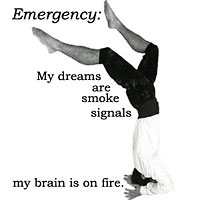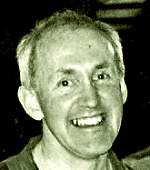
Dr Mark Seton
reviews
The Kamikaze Mind
by Richard James Allen
157pp. Brandl & Schlesinger. Paperback. AUD$.24.95
This review is about 4 printed pages long. It is copyright © Dr Mark Seton and Richard James Allen and Jacket magazine 2007.
paragraph 1
What more can be said, or more particularly, written about a literary work that has already been highly lauded by many reviewers in the Australian press? Perhaps, only about how another body finds itself responding to the gestures on offer from the author. For me, as a performer, I find myself engaging in the ‘dancing with words’ that Allen, also a dancer and choreographer, embodies in The Kamikaze Mind.
2
The word “kamikaze” can translate as “God” or “Divine” wind, with a mythic reference to typhoon winds that destroyed threatening invaders. Subsequently, it also came to refer to the sacrifice of pilots to prevent similar invading attacks from the US in World War 2. Thus the title and subsequent provocation for this poetic ‘documentation’ are both intriguing starting points for this unique collection of writings. A distinction is made between Hawkings’ account of an astronaut who ‘falls’ into a black hole and Allen’s documenting of an astronaut who “launched’ himself into a black hole. A further provocation is made between the notion of recycling as a kind of immortality, in the case of Hawkings, and the fragmentary, yet conventionally organised, after-life of Allen’s kamikaze-like astronaut. After reading this work, it’s possible to have a sense that one of its intent may be to offer protection, if not release, from the encroaching gravitas of contemporary Western society.

3
In Allen’s book launch address, he describes his work as “the portrait of the mind of a metaphorical astronaut who has destroyed his mind in order to free it. It is the portrait of a mind, caught in its delusions, but also attempting to ‘turn about in the seat of consciousness”. However, my experience of reading this lexicon has proved to be as much an engagement of the visceral as the rational or delusional. I regard it as a kind of glossalia-ry – a gathering together of sonic movements that transmute into mis-recognised words and multi-ported meanings. They are as much provocations that resonate and reverberate as they meet each new reader:
4
Faith I don’t believe in God, but maybe God believes in me.
Faith Love is the invisible bridge between you and me, it takes all my faith to walk across it.
5
No matter how you may engage this work, whether reading it from cover to cover, or dipping in and out, you may find it variously confronting, jarring, amusing, confusing, touching – sometimes concurrently. While knowing Allen to be of male gender and presuming his astronaut persona to also be male, I was delightfully startled by many of the entries that signaled shifts in the subjectivity of gender or sexual orientation:
6
Measurement He looked at me with that smile. “I am counting the number of times I have raped you and you have done nothing about it. Should I measure the value of this by what I accumulate or by what you give away?”
Compliment I thought, I shouldn’t ask her for compliments, she’s with me, I guess that’s compliment enough.
7
What becomes a constant reminder that this text is generated from a living body rather than a disembodied consciousness are the photographic images of Allen in various positions of ‘free fall’ that preface each chapter (arranged in alphabetical order). Likewise, the inter-penetrability of language is visually modelled by use of various typographical devices. On one page, the word ‘yes’ is located on the four extreme edges of the page with a definition in the middle of the page stating “I am imprisoned in this page”. Elsewhere, bold type that identifies a new word entry, rather than remaining a stable ‘other’ from which a set range of meanings may be derived, does not prevent the word eliding into its contextually fluid extrapolation of meaning-making.
8
BYO history.
Conditions Apply.
Confession To what would he admit? And I?
9
Ultimately, Allen’s interrogation of identity doesn’t result in the solution of mystery, the uncovering of hidden facts or unquestionable truths, the locating of that which was presumed to be missing. Rather, he re-minds, or more accurately, re-embodies the reader-participant in the complicity and complexity of the ways human beings use language with each other, as they are in-formed by each other’s language.
10
Desire I hate desire.
Desire Was she afraid I would uncover her mystery, reduce the magic to a hole, some fluids, the toss of a head, a buoyancy of skin? She shouldn’t have worried. Even after the mystery is gone, there’s still the mystery.
Desires What does he desire when his desires have been satisfied?
Dictionary A dictionary of good and bad thoughts. Can you tell the difference?
Dictionary A mind field. Be careful where you step.
Dictionary A self-portrait of language.
Soul It’s your job to tell me the truth. “Everything you have will be taken from you. There’s only one thing you can keep. Don’t lose that.” Only you don’t tell me what it is.
Soul She wanted to warn me, “I love you with all my heart, but I have an unfaithful soul.”
Soul You take pity on me. “There is only one moment. But it lasts forever. That part of you able to perceive this moment is your soul.”
Zero I am at the crossroads of too many philosophies and about to be run over.
Zero Should I jump? Where’s the floor?
Zero The number off the bottom rung of mathematics.
Zero Void. God.
11
The Kamikaze Mind is a unique compilation of poetic formations and ruminations permitting the reader to either wade in the shallows of a few pages or dive into the depths of reading systematically from one alphabetical marker to the next. It may amuse, bemuse, shock, confront, disturb, or caress the senses as one slides through each entry. As in free fall, there is exhilaration and anxiety to be experienced in the same moment. Allen has created a bold, choreographic project of juxtaposing a myriad of embodied and linguistic encounters over and, often, against each other. The persistent reader will find great reward in joining in the ‘dance’ between and across its pages.

|
Dr Mark Cariston Seton is a lecturer, organisational consultant, performance mentor and InterPlay® teacher. He has worked variously as an editor, production manager, director, writer and producer in film and video production and as a dramaturg for contemporary performance. He is an Honorary Research Associate with the Department of Performance Studies, University of Sydney. |
The Internet address of this page is http://jacketmagazine.com/33/seton-allen.shtml